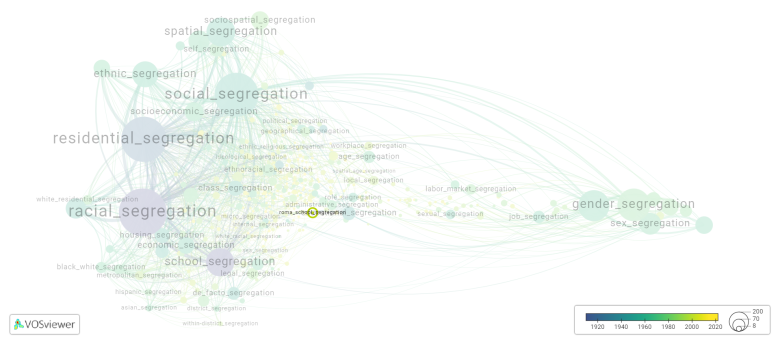Roma school segregation: Difference between revisions
(Creating page) |
(Creating page) |
||
| (4 intermediate revisions by the same user not shown) | |||
| Line 13: | Line 13: | ||
Efforts to combat Roma school segregation include implementing policies and legal frameworks that promote equal educational opportunities for all, providing language support for Roma children, and supporting the integration of Roma students into mainstream schools. However, significant challenges remain in achieving full educational equality for Roma children. | Efforts to combat Roma school segregation include implementing policies and legal frameworks that promote equal educational opportunities for all, providing language support for Roma children, and supporting the integration of Roma students into mainstream schools. However, significant challenges remain in achieving full educational equality for Roma children. | ||
==== | ==See also== | ||
==Related segregation forms== | |||
Roma school segregation is frequently discussed in the literature with the following segregation forms: | |||
[[school segregation]], [[educational segregation]] | |||
[[File:roma_school_segregation.png|780x780px]] | |||
This visualization is based on the study [[Segregation_Wiki:About| The Multidisciplinary Landscape of Segregation Research]]. | |||
For the complete network of interrelated segregation forms, please refer to: | |||
* [https://tinyurl.com/2235lkhw First year of publication] | |||
* [https://tinyurl.com/2d8wg5n3 Louvain clusters] | |||
* [https://tinyurl.com/223udk5r Betweenness centrality] | |||
* [https://tinyurl.com/244d8unz Disciplines in which segregation forms first emerged (Scopus database).] | |||
==References== | ==References== | ||
==Notes== | ==Notes== | ||
<references /> | <references /> | ||
{{NoteAI}} | {{NoteAI}} | ||
==Roma | ==Roma school segregation appears in the following literature== | ||
Greernberg J. ( | Greernberg J. (201). Report on roma education today: From slavery to segregation and beyond. ''Columbia Law Review'', ''110''(4), 919-1001. https://doi.org/ | ||
O’Nions H. (2015 | O’Nions H. (2015). Narratives of social inclusion in the context of roma school segregation. ''Social Inclusion'', ''3''(5), 103-114. Cogitatio Press.https://doi.org/10.17645/si.v3i5.258 | ||
Latest revision as of 07:17, 16 October 2024
Date and country of first publication[1][edit | edit source]
2010
United States
Definition[edit | edit source]
Roma school segregation refers to the practice of separating Roma, also known as Gypsies, from non-Roma students in educational institutions. This form of discrimination is prevalent in many European countries, where Roma communities historically face marginalized and impoverished living conditions.
Roma school segregation can manifest in different ways, such as placing Roma children in separate classrooms or schools, or segregating them within mainstream schools. It often stems from negative stereotypes and prejudices against the Roma community, resulting in limited access to quality education and perpetuating a cycle of poverty and social exclusion.
There are several factors contributing to Roma school segregation, including the language barrier, cultural differences, and socio-economic disparities. Many Roma families live in segregated communities with limited resources and support, leading to reduced educational opportunities.
International and regional human rights organizations, as well as some national governments, have recognized the issue and made efforts to tackle Roma school segregation. They emphasize the importance of inclusive education, promoting integration, and addressing the root causes of discrimination against the Roma community.
Efforts to combat Roma school segregation include implementing policies and legal frameworks that promote equal educational opportunities for all, providing language support for Roma children, and supporting the integration of Roma students into mainstream schools. However, significant challenges remain in achieving full educational equality for Roma children.
See also[edit | edit source]
Related segregation forms[edit | edit source]
Roma school segregation is frequently discussed in the literature with the following segregation forms:
school segregation, educational segregation

This visualization is based on the study The Multidisciplinary Landscape of Segregation Research.
For the complete network of interrelated segregation forms, please refer to:
References[edit | edit source]
Notes[edit | edit source]
- ↑ Date and country of first publication as informed by the Scopus database (December 2023).
At its current state, this definition has been generated by a Large Language Model (LLM) so far without review by an independent researcher or a member of the curating team of segregation experts that keep the Segregation Wiki online. While we strive for accuracy, we cannot guarantee its reliability, completeness and timeliness. Please use this content with caution and verify information as needed. Also, feel free to improve on the definition as you see fit, including the use of references and other informational resources. We value your input in enhancing the quality and accuracy of the definitions of segregation forms collectively offered in the Segregation Wiki ©.
Roma school segregation appears in the following literature[edit | edit source]
Greernberg J. (201). Report on roma education today: From slavery to segregation and beyond. Columbia Law Review, 110(4), 919-1001. https://doi.org/
O’Nions H. (2015). Narratives of social inclusion in the context of roma school segregation. Social Inclusion, 3(5), 103-114. Cogitatio Press.https://doi.org/10.17645/si.v3i5.258
